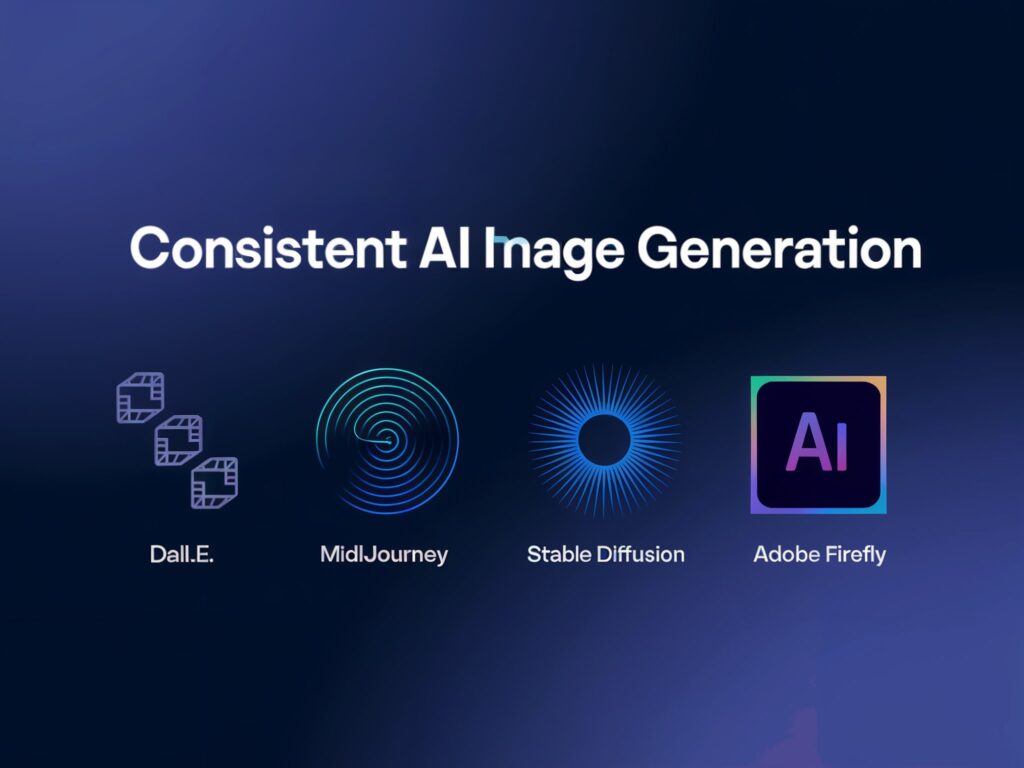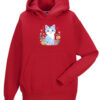In recent years, the field of artificial intelligence has made remarkable strides, particularly in the domain of image generation. From rudimentary pixelated outputs to photorealistic renderings, AI-powered tools have transformed how we create and interact with visual content. Platforms like DALL·E, Mid-Journey, Stable Diffusion, and Adobe Firefly have become household names, offering users unprecedented control over artistic expression. However, one of the most fascinating advancements within this realm is the ability to generate consistent AI characters. This ability to create consistent AI characters bridges the gap between static imagery and dynamic storytelling.

Consistent AI characters refer to the ability of AI systems to produce recurring visual identities across multiple images while maintaining key attributes such as facial features, clothing styles, poses, or contextual elements. This capability is invaluable for creators who need cohesive visuals for projects like comic books, video games, marketing campaigns, or even social media content. For instance, imagine designing a character for a children’s book series where the protagonist appears in various settings—be it exploring a jungle, attending school, or celebrating a birthday. Without consistency, the character risks losing its identity, confusing audiences and diluting the narrative impact.
When creating consistent AI characters, it is essential to focus on their recurring visual identities, as consistent AI characters also enhance storytelling. Consistent AI characters provide a strong foundation for narratives, ensuring that audiences can easily identify with the characters throughout various scenarios.
Moreover, consistent AI characters enhance the emotional connection to the story. The more consistent AI characters are, the more likely viewers are to feel attached to them, reinforcing the overall narrative. This attachment can be crucial in marketing campaigns where consistent AI characters play a pivotal role in brand recognition.
The importance of consistent AI characters extends beyond aesthetics; it fosters emotional connection and brand recognition. When viewers encounter a familiar face or figure repeatedly, they develop an attachment, making the story or message more memorable. In professional contexts, consistency ensures alignment with branding guidelines, enhancing trust and reliability. As AI image generation continues to evolve, achieving this level of precision has become not just desirable but essential for high-quality creative work. By leveraging advanced algorithms and user-friendly interfaces, modern tools empower both amateurs and professionals to bring their visions to life with unparalleled accuracy and efficiency.
These tools are particularly important for generating consistent AI characters, as they allow for better iterations and refinements to achieve the desired look.
For creators, using tools that focus on consistent AI characters can dramatically improve workflow and results, making it easier to achieve their vision.
1. Exploring Major AI Image Generation Tools
When it comes to creating consistent characters, the landscape of AI image generation tools offers a diverse array of options, each with its own strengths and limitations. Among the most prominent platforms are DALL·E, MidJourney, Stable Diffusion, and Adobe Firefly. These tools cater to different needs, ranging from free, open-source solutions to premium, subscription-based services, making them accessible to creators at all levels of expertise.
Consistent AI characters can also serve as a branding tool, presenting a unified image across different types of media and marketing materials.
Focusing on consistent AI characters can lead to more engaging and memorable interactions in various applications, whether it be in advertisements or storytelling.
DALL·E, developed by OpenAI, stands out for its ability to interpret complex prompts and generate highly detailed images. Its strength lies in understanding nuanced descriptions, which can be particularly useful when defining specific traits for consistent characters, such as hairstyles, outfits, or expressions. However, while DALL·E excels in creativity and versatility, maintaining absolute consistency across multiple generations can sometimes prove challenging without meticulous prompt engineering. On the other hand, MidJourney has gained acclaim for its artistic flair and stylistic coherence. Known for producing visually striking results, MidJourney allows users to refine outputs iteratively, enabling greater control over character consistency. Yet, its reliance on Discord-based interactions and subscription pricing may deter some casual users.
Stable Diffusion, an open-source alternative, democratizes access to AI image generation by offering a free, customizable platform. Its community-driven nature encourages experimentation, and users can fine-tune models to achieve precise character consistency. While it requires more technical know-how compared to its commercial counterparts, the flexibility it provides is unmatched. Conversely, Adobe Firefly positions itself as a polished, user-friendly option tailored for professional workflows. Integrated seamlessly into Adobe’s ecosystem, Firefly emphasizes ethical sourcing of training data and prioritizes ease of use. However, its relatively recent launch means it still lags behind competitors in terms of advanced features for character consistency.
Each tool presents unique trade-offs between accessibility, functionality, and cost. For those seeking affordability and customization, Stable Diffusion is ideal, whereas professionals might prefer the refined outputs of DALL·E or Firefly. Meanwhile, MidJourney strikes a balance between artistry and iterative refinement. Understanding these distinctions helps creators choose the right platform based on their specific requirements for generating consistent characters.
The versatility of consistent AI characters allows them to adapt to various scenarios, making them invaluable for creators across different mediums.
2.1. Achieving Consistent Characters Across Platforms
Utilising consistent AI characters ensures that the stories told remain relatable and easily digestible for audiences of all ages.
Achieving consistent characters through AI image generation involves mastering both the technical aspects of these tools and the art of crafting effective prompts. One of the most critical techniques is prompt engineering, where the specificity and clarity of your input directly influence the output’s fidelity. For example, instead of simply requesting “a wizard,” you might specify “a tall wizard with silver hair, wearing a blue robe adorned with golden stars, holding a glowing staff.” This level of detail ensures that the AI generates a character with recognizable attributes across multiple iterations. Additionally, many platforms allow users to upload reference images or style guides, further anchoring the AI’s interpretation to a fixed visual identity.
Another powerful method is utilizing seed values, a feature available in tools like Stable Diffusion and MidJourney. A seed value acts as a numerical identifier that locks the randomization process, ensuring that subsequent generations retain the same foundational structure. By saving and reusing seed values, creators can maintain consistency in facial features, body proportions, and even lighting conditions. Similarly, some platforms offer model fine-tuning capabilities, enabling users to train the AI on custom datasets. For instance, uploading a series of images featuring your desired character allows the system to learn and replicate their unique traits more accurately.
Despite these advantages, challenges persist. Variability in outputs remains a common issue, as slight changes in phrasing or parameters can lead to unintended deviations. Moreover, certain tools struggle with preserving intricate details, such as accessories or background elements, over repeated generations. To mitigate these issues, creators often combine multiple techniques—leveraging both prompt refinement and seed locking—to maximize consistency. By understanding and strategically applying these methods, users can harness the full potential of AI tools to produce cohesive and compelling characters.
2.2. Real-World Applications of Consistent Characters
The future developments in AI are likely to enhance the capabilities of consistent AI characters, making them even more integral to creative projects.
As technology advances, the creation of consistent AI characters will become more seamless and accessible, allowing for richer narratives and deeper audience connections.
The ability to generate consistent characters using AI image generation tools has revolutionized numerous industries, offering practical solutions that enhance creativity and efficiency. In entertainment, filmmakers and game developers leverage these technologies to streamline character design processes. For instance, a video game studio might use MidJourney or Stable Diffusion to create a protagonist whose appearance remains uniform across cutscenes, gameplay, and promotional materials. This ensures players develop a strong connection with the character, reinforcing immersion and narrative engagement. Similarly, animation studios employ AI-generated consistent characters to prototype designs quickly, reducing production timelines while maintaining visual cohesion throughout episodic content.
In the long run, this evolution will ensure that the potential of consistent AI characters in storytelling and marketing is fully realised.
Marketing and advertising also benefit significantly from this innovation. Brands rely on consistent AI characters to establish recognizable mascots or spokespersons that resonate with audiences. For instance, a global campaign featuring a consistent AI character can promote sustainability initiatives across various platforms. Tools like DALL·E or Adobe Firefly enable marketers to generate variations of these consistent AI characters interacting with different environments—retaining core visual elements while adapting to different contexts.
Beyond commercial applications, educators and content creators utilize AI-generated characters to enrich storytelling and learning experiences. Picture a children’s book author designing a recurring hero who embarks on diverse adventures. By employing AI tools, they can effortlessly adapt the character to new scenarios without compromising their established look or personality. Such versatility not only saves time but also enhances the quality and appeal of educational resources, making them more engaging for young readers. These real-world examples underscore how consistent characters bridge gaps between imagination and execution, empowering creators to deliver impactful, cohesive narratives across various mediums.
3. Addressing Ethical and Creative Challenges
While AI image generation tools have undeniably revolutionized the creation of consistent characters, they also raise significant ethical concerns and creative challenges. One pressing issue is the risk of perpetuating biases embedded within training datasets. AI systems often inherit stereotypes related to gender, race, or cultural representation, which can manifest in generated characters. For instance, a prompt requesting “a business leader” might disproportionately yield images of white male figures, reinforcing outdated societal norms. Creators must remain vigilant, actively auditing outputs and refining prompts to counteract such biases. Some platforms, like Adobe Firefly, emphasize ethical sourcing of training data, but broader industry accountability is still needed to ensure equitable representation.
Intellectual property rights present another challenge. Many AI models are trained on vast repositories of publicly available images, raising questions about consent and ownership. If an AI replicates a character resembling a copyrighted figure, it could lead to legal disputes. To navigate this, creators should prioritize originality in their prompts and avoid relying heavily on existing works. Additionally, transparency from tool developers regarding dataset origins would foster greater trust and compliance.
On the creative front, over-reliance on AI risks stifling human ingenuity. While these tools excel at consistency, they may lack the nuance and emotional depth that come from manual craftsmanship. Striking a balance is key—using AI as a collaborative partner rather than a replacement. By combining algorithmic precision with human intuition, creators can produce consistent characters that are both technically accurate and artistically compelling, addressing both ethical considerations and creative aspirations.
4. The Future of Consistent Characters in AI Image Generation
As AI image generation technology continues to advance, the future of consistent characters holds immense promise for creators and industries alike. Emerging trends suggest that upcoming innovations will focus on enhancing personalization, interactivity, and scalability. For instance, researchers are exploring adaptive AI models capable of learning from minimal input, allowing users to define a character’s traits with even greater precision. Imagine a tool that can generate a consistent character based solely on a brief verbal description or a single sketch, eliminating the need for extensive prompt engineering. Such advancements would democratize access to high-quality character design, empowering creators of all skill levels to bring their visions to life effortlessly.
Moreover, the integration of AI with virtual and augmented reality platforms could redefine how consistent characters are utilized. Envision immersive storytelling experiences where AI-generated characters dynamically interact with users in real-time, adapting their appearances and behaviors based on contextual cues. This level of interactivity would revolutionize fields like gaming, education, and marketing, offering unparalleled engagement opportunities. Additionally, cloud-based collaboration tools may enable teams to co-create and refine consistent characters seamlessly, regardless of geographical boundaries.
For creators, staying informed about these developments is crucial to harnessing the full potential of AI image generation. By experimenting with new features, participating in beta programs, and engaging with online communities, they can remain at the forefront of this rapidly evolving landscape. As AI continues to blur the lines between imagination and reality, the ability to craft consistent characters will not only shape narratives but also redefine how we connect with digital content.





